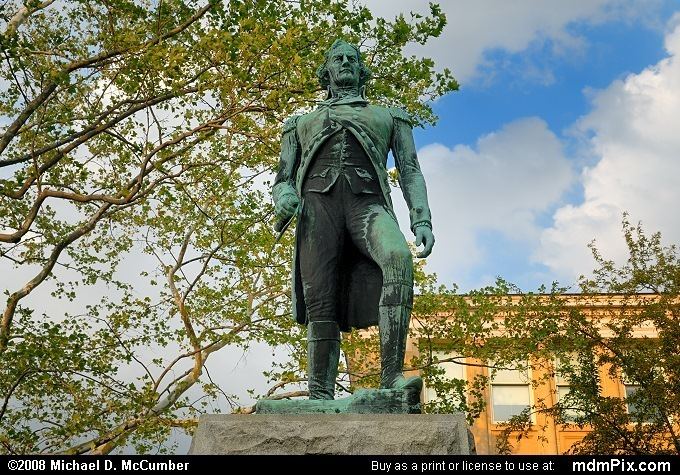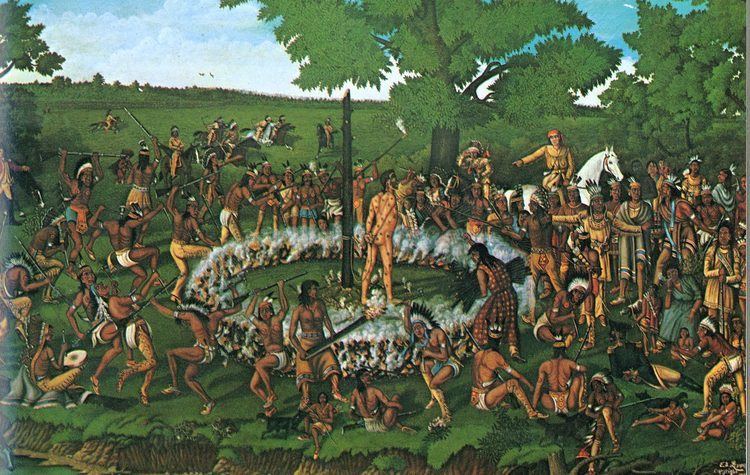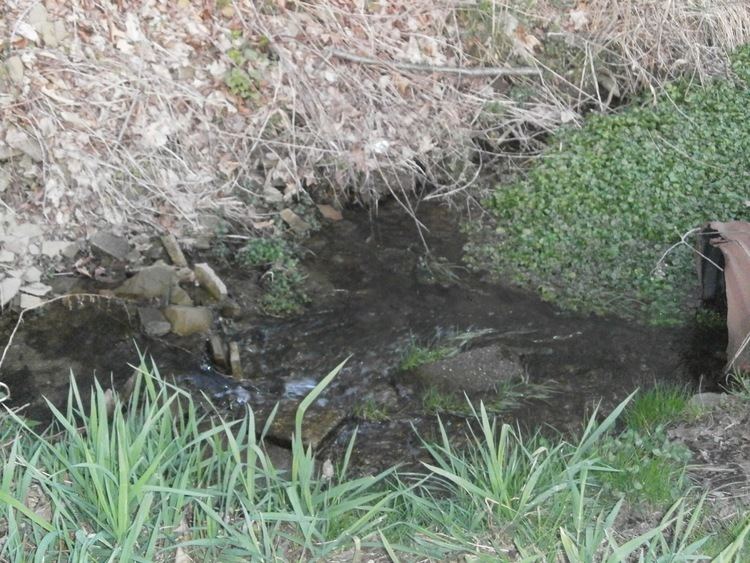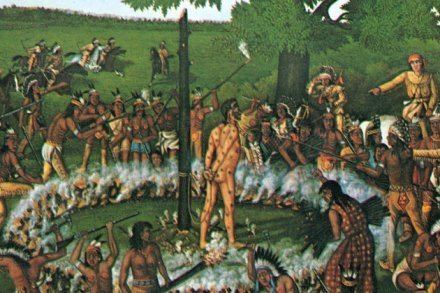Name William Crawford | Role Soldier | |
 | ||
Books The Washington-Crawford Letters, Fire in the Marrow Similar People John Murray - 4th Earl of Du, George Washington, Andrew Lewis, Cornstalk, Samuel Wharton | ||
William Crawford (2 September 1722 – 11 June 1782) was an American soldier and surveyor who worked as a western land agent for George Washington. Crawford fought in the French and Indian War and the American Revolutionary War. He was tortured and burned at the stake by American Indians in retaliation for the Gnadenhutten massacre, a notorious incident near the end of the American Revolution.
Contents

Early career

In 1722, Crawford was born in Orange County, Virginia, at a location which is now in Berkeley County, West Virginia. He was a son of William Crawford and his wife Honora Grimes, who were Scots-Irish farmers. After his father's death in 1736, his mother married Richard Stephenson. Crawford had a younger brother, Valentine Crawford, plus five half-brothers and one half-sister from his mother's second marriage.

In 1742 Crawford married one Ann Stewart and she bore him one child, a daughter also named Ann, born in 1743. Apparently she died in childbirth or soon after, and on 5 January 1744 he married Hannah Vance, said to have been born in Pennsylvania in 1723. She bore him a son named John (20 April 1744 – 22 September 1816; he married one Effie Grimes) and at least two daughters, Ophelia "Effie" (2 September 1747–1825, who married Captain William McCormick who was born Feb 2, 1738, and died August 15, 1816), and Sarah (1752–10 Nov 1838, who married 1)Major William Harrison [c 1740–13 June 1782], and 2) Lt. Col Uriah Springer [18 Nov 1754–21 Sep 1826]}. There may also have been another daughter, Nancy, born in 1767, who had apparently died when he wrote his will in 1782.

In 1749, Col. William Crawford became acquainted with George Washington, then a young surveyor somewhat younger than Crawford. He accompanied Washington on surveying trips and learned the trade. In 1755, Crawford served in the Braddock expedition with the rank of ensign. Like Washington, he survived the disastrous Battle of the Monongahela. During the French and Indian War, he served in Washington's Virginia Regiment, guarding the Virginia frontier against Native American raiding parties. In 1758, Crawford was a member of General John Forbes's army which captured Fort Duquesne, where Pittsburgh, Pennsylvania now stands. He continued to serve in the military, taking part in Pontiac's War in 1763.
In 1765 Crawford built a cabin on the Braddock Road along the Youghiogheny River in what is now Connellsville, Fayette County, Pennsylvania. His wife and three children joined him there the following year. Crawford supported himself as a farmer and fur trader. When the 1768 Treaty of Fort Stanwix with the Iroquois opened up additional land for settlement, Crawford worked again as a surveyor, locating lands for settlers and speculators. Governor Robert Dinwiddie had promised bounty land to the men of the Washington's Virginia Regiment for their service in the French and Indian War. In 1770 Crawford and Washington travelled down the Ohio River to choose the land to be given to the regiment's veterans. The area selected was near what is now Point Pleasant, West Virginia. Crawford also made a western scouting trip in 1773 with Lord Dunmore, Governor of Virginia. Washington could not accompany them because of the sudden death of his stepdaughter.
At the outbreak of Dunmore's War in 1774, Crawford received a major's commission from Lord Dunmore. He built Fort Fincastle at present Wheeling, West Virginia. He also led an expedition which destroyed two Mingo villages (near present Steubenville, Ohio) in retaliation for Chief Logan's raids into Virginia. During the expedition, Crawford's men rescued two captives held by American Indians, killing six and capturing 14 Indians.
Crawford's service to Virginia in Dunmore's War was controversial in Pennsylvania, since the colonies were engaged in a bitter dispute over their borders near Fort Pitt. Crawford had been a justice of the peace in Pennsylvania since 1771, first for Bedford County, then for Westmoreland County when it was established in 1773. Arthur St. Clair, another Pennsylvania official, called for Crawford to be removed from his office, which was done in January 1775. Beginning in 1776, Crawford served as a surveyor and justice for Virginia's short-lived Yohogania County.
American Revolution
When the American Revolutionary War began, Crawford recruited a regiment for the Virginia Line of the Continental Army. On 11 October 1776, the Continental Congress appointed him colonel of the 7th Virginia Regiment. Crawford led his regiment in the Battle of Long Island and the retreat across New Jersey. He crossed the Delaware with Washington and fought at the battles of Trenton and Princeton. During the Philadelphia campaign, he commanded a scouting detachment for Washington's army.
After the war on the western frontier intensified in 1777, Crawford was transferred to the Western Department of the Continental Army. He served at Fort Pitt under Generals Edward Hand and Lachlan McIntosh. Crawford was present at the Treaty of Fort Pitt in 1778, and helped to build Fort Laurens and Fort McIntosh that year. Resources were scarce on the frontier, however, and Fort Laurens was abandoned in 1779. In 1780, Crawford visited Congress to appeal for more funds for the western frontier. In 1781, he retired from military service.
Crawford expedition
In 1782, General William Irvine persuaded Crawford to come out of retirement and lead an expedition against enemy Indian villages along the Sandusky River. Before leaving, on 16 May he made out his will and testament. His son John Crawford, his son-in-law William Harrison, and his nephew and namesake William Crawford also joined the expedition.
After his election as commander of the expedition, Crawford led about 500 volunteers deep into American Indian territory with the hope of surprising them. However, the Indians and their British allies at Detroit had learned about the expedition in advance, and brought about 440 men to the Sandusky to oppose the Americans. After a day of indecisive fighting, the Americans found themselves surrounded. During a confused retreat, Crawford and dozens of his men were captured. The Indians executed many of them in retaliation for the Gnadenhutten massacre earlier in the year, in which 96 peaceful Christian Indian men, women, and children had been murdered by Pennsylvanian militiamen. Crawford's execution was brutal; he was tortured for at least two hours before he was burned at the stake. His nephew and son-in-law were also captured and executed. The war ended shortly thereafter, but Crawford's horrific execution was widely publicized in the United States, worsening the already strained relationship between Native Americans and European Americans.
Crawford’s torture and execution by the Indians is described in graphic detail by Allan W. Eckert in That Dark and Bloody River
In 1982, the site of Colonel Crawford's execution was added to the National Register of Historic Places. In 1994, the Wyandot County Patriotic Citizens erected an 8.5 ft (2.6 m) Berea sandstone monument near the site. The Ohio Historical Society also has an historical marker nearby.
Crawford County, Ohio, Crawford County, Pennsylvania, Crawford County, Michigan and Crawford County, Indiana are named for William Crawford. So too is Colonel Crawford High School in North Robinson, Ohio.
There is a replica of Crawford's cabin in Connellsville, Pennsylvania.
